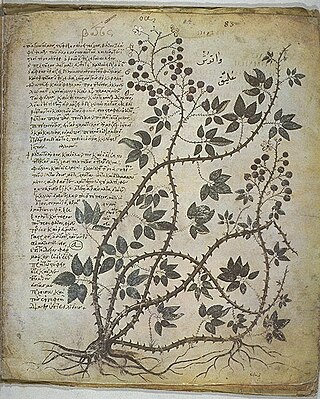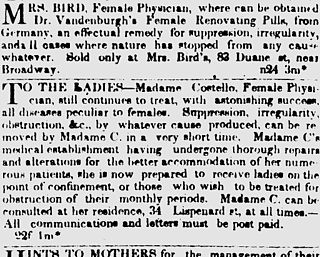Related Research Articles

Mentha pulegium, commonly (European) pennyroyal, or pennyrile, also called mosquito plant and pudding grass, is a species of flowering plant in the mint family, Lamiaceae, native to Europe, North Africa, and the Middle East. Crushed pennyroyal leaves emit a very strong fragrance similar to spearmint. Pennyroyal is a traditional folk remedy, emmenagogue, abortifacient, and culinary herb, but is toxic to the liver and has caused some deaths. European pennyroyal is related to an American species, Hedeoma pulegioides. Though they differ in genera, they share similar chemical properties.

Pedanius Dioscorides, "the father of pharmacognosy", was a Greek physician, pharmacologist, botanist, and author of De materia medica —a 5-volume Greek encyclopedia about herbal medicine and related medicinal substances, that was widely read for more than 1,500 years. For almost two millennia Dioscorides was regarded as the most prominent writer on plants and plant drugs.

Materia medica is a Latin term from the history of pharmacy for the body of collected knowledge about the therapeutic properties of any substance used for healing. The term derives from the title of a work by the Ancient Greek physician Pedanius Dioscorides in the 1st century AD, De materia medica, 'On medical material'.

A potion is a liquid "that contains medicine, poison, or something that is supposed to have magic powers." It derives from the Latin word potio which refers to a drink or the act of drinking. The term philtre is also used, often specifically for a love potion, a potion that is supposed to create feelings of love or attraction in the one who drinks it. Throughout history there have been several types of potions for a range of purposes. Reasons for taking potions ranged from curing an illness, to securing immortality to trying to induce love. These potions, while often ineffective or poisonous, occasionally had some degree of medicinal success depending on what they sought to fix and the type and amount of ingredients used. Some popular ingredients used in potions across history include Spanish fly, nightshade plants, cannabis, and opium.

Silphium, σίλφιον (sílphion) in ancient Greek, is an unidentified plant that was used in classical antiquity as a seasoning, perfume, aphrodisiac, and medicine.

An abortifacient is a substance that induces abortion. This is a nonspecific term which may refer to any number of substances or medications, ranging from herbs to prescription medications.

Medicinal plants, also called medicinal herbs, have been discovered and used in traditional medicine practices since prehistoric times. Plants synthesize hundreds of chemical compounds for various functions, including defense and protection against insects, fungi, diseases, and herbivorous mammals.

Apothecary is an archaic English term for a medical professional who formulates and dispenses materia medica (medicine) to physicians, surgeons and patients. The modern terms 'pharmacist' and 'chemist' have taken over this role.
Emmenagogues are herbs which stimulate blood flow in the pelvic area and uterus; some stimulate menstruation. Women use emmenagogues to stimulate menstrual flow, when menstruation is absent for reasons other than pregnancy, such as hormonal disorders or conditions like oligomenorrhea.

Ruta graveolens, commonly known as rue, common rue or herb-of-grace, is a species of the genus Ruta grown as an ornamental plant and herb. It is native to the Balkan Peninsula. It is grown throughout the world in gardens, especially for its bluish leaves, and sometimes for its tolerance of hot and dry soil conditions. It is also cultivated as a culinary herb, and to a lesser extent as an insect repellent and incense.

A self-induced abortion is an abortion performed by the pregnant woman herself, or with the help of other, non-medical assistance. Although the term includes abortions induced outside of a clinical setting with legal, sometimes over-the-counter medication, it also refers to efforts to terminate a pregnancy through alternative, potentially more dangerous methods. Such practices may present a threat to the health of women.

In the history of medicine, "Islamic medicine" is the science of medicine developed in the Middle East, and usually written in Arabic, the lingua franca of Islamic civilization.

Aëtius of Amida was a Byzantine Greek physician and medical writer, particularly distinguished by the extent of his erudition. His birth and death years are not known, but his writings appear to date from the end of the 5th century or the beginning of the 6th.

The practice of induced abortion—the deliberate termination of a pregnancy—has been known since ancient times. Various methods have been used to perform or attempt abortion, including the administration of abortifacient herbs, the use of sharpened implements, the application of abdominal pressure, and other techniques. The term abortion, or more precisely spontaneous abortion, is sometimes used to refer to a naturally occurring condition that ends a pregnancy, that is, to what is popularly called a miscarriage. But in what follows the term abortion will always refer to an induced abortion.
Christianity and abortion has a long and complex history. There is scholarly disagreement on how early Christians felt about abortion. Some scholars have concluded that early Christians took a nuanced stance on what is now called abortion, and that at different and in separate places early Christians have taken different stances. Other scholars have concluded that early Christians considered abortion a sin at all stages; though there is disagreement over their thoughts on what type of sin it was and how grave a sin it was held to be. Some early Christians believed that the embryo did not have a soul from conception, and consequently opinion was divided as to whether early abortion was murder or ethically equivalent to murder. Some early Christian texts nonetheless condemned abortion without distinction: Luker mentions the Didache, Clement of Alexandria, Tertullian, and Saint Basil. Early church councils punished women for abortions that were combined with other sexual crimes, as well as makers of abortifacient drugs, but, like some early Church Fathers such as Basil of Caesarea, did not make distinction between "formed" and "unformed" fetuses.

The history of pharmacy as a modern and independent science dates back to the first third of the 19th century. Before then, pharmacy evolved from antiquity as part of medicine. The history of pharmacy coincides well with the history of medicine, but it's important that there is a distinction between the two topics. Pharmaceuticals is one of the most-researched fields in the academic industry, but the history surrounding that particular topic is sparse compared to the impact its made world-wide. Before the advent of pharmacists, there existed apothecaries that worked alongside priests and physicians in regard to patient care.
The history of birth control, also known as contraception and fertility control, refers to the methods or devices that have been historically used to prevent pregnancy. Planning and provision of birth control is called family planning. In some times and cultures, abortion had none of the stigma which it has today, making birth control less important.
The history of herbalism is closely tied with the history of medicine from prehistoric times up until the development of the germ theory of disease in the 19th century. Modern medicine from the 19th century to today has been based on evidence gathered using the scientific method. Evidence-based use of pharmaceutical drugs, often derived from medicinal plants, has largely replaced herbal treatments in modern health care. However, many people continue to employ various forms of traditional or alternative medicine. These systems often have a significant herbal component. The history of herbalism also overlaps with food history, as many of the herbs and spices historically used by humans to season food yield useful medicinal compounds, and use of spices with antimicrobial activity in cooking is part of an ancient response to the threat of food-borne pathogens.
Medieval contraception is a debated topic among historians, though methods of contraception have been developed not just in modern times. In ancient times, women attempted to protect themselves from unwanted pregnancy with various means and practices, as evidenced by ancient records. Ancient and medieval manuscripts provide glimpses into diverse birth control practices.

De materia medica is a pharmacopoeia of medicinal plants and the medicines that can be obtained from them. The five-volume work was written between 50 and 70 CE by Pedanius Dioscorides, a Greek physician in the Roman army. It was widely read for more than 1,500 years until supplanted by revised herbals in the Renaissance, making it one of the longest-lasting of all natural history and pharmacology books.
References
- ↑ Touwaide, Alain (2012). "Introduction". In Van Arsdall, Anne; Graham, Timothy (eds.). Herbs and Healers from the Ancient Mediterranean through the Medieval West: Essays in Honor of John M. Riddle. Medicine in the Medieval Mediterranean. Vol. 4. Ashgate Publishing. p. 5. ISBN 9781409456667.
- ↑ Riddle, John M. (1980). "Dioscorides" (PDF). Catalogus Translationum et Commentariorum . IV: 1–143.
- ↑ Riddle, John M. (1986). Dioscorides on Pharmacy and Medicine. History of Science Series. Vol. 3. University of Texas Press. ISBN 9780292729841.
- ↑ Parker, Linette A. (1915). "A Brief History of Materia Medica". The American Journal of Nursing . 15 (9): 650–653. doi: 10.2307/3404081 . JSTOR 3404081.
Parker, Linette A. (1915). "A Brief History of Materia Medica (continued)". The American Journal of Nursing . 15 (10): 729–734. doi: 10.2307/3404151 . JSTOR 3404151. - ↑ Le Wall, Charles Herbert (1927). Four Thousand Years of Pharmacy: An Outline History of Pharmacy and the Allied Sciences. J. B. Lippincott & Co.
- ↑ Reeds, Karen (1987). "Dioscorides Unriddled: An Essay Review of Dioscorides on Pharmacy and Medicine by John M. Riddle". Isis . 78 (1): 85–88. doi:10.1086/354334. PMID 3294735. S2CID 71469173.
- ↑ Riddle, John M. (1994). Contraception and Abortion from the Ancient World to the Renaissance (Illustrated and Revised ed.). Harvard University Press. ISBN 9780674168763.
- ↑ Riddle, John M. (1997). Eve's herbs: a history of contraception and abortion in the West. Cambridge, MA: Harvard University Press. ISBN 978-0-674-27024-4. OCLC 36126503.
- ↑ Riddle, John M. (1996). "Contraception and Early Abortion in the Middle Ages". In Bullough, Vern L.; Brundage, Jame A. (eds.). Handbook of Medieval Sexuality. New York: Taylor & Francis. pp. 261–279 (particularly pp. 263 and 274). ISBN 9780815312871.
- 1 2 van de Walle, Etienne (1997). "Flowers, Fruits: Two Thousand Years of Menstrual Regulation". Journal of Interdisciplinary History . 28 (2): 182–203. doi:10.2307/206401. JSTOR 206401.
- ↑ Ferngren, Gary B. (1997). "Eve's Herbs: A History of Contraception and Abortion in the West By John M. Riddle (review)". New England Journal of Medicine (Book review). 337 (19): 1398. doi:10.1056/NEJM199711063371920.
- ↑ Santow, Gigi (1998). "Reviewed Work: Eve's Herbs: A History of Contraception and Abortion in the West by John M. Riddle". Population and Development Review (Book review). 24 (4): 869–874. doi:10.2307/2808033. JSTOR 2808033. PMC 1044062 .
- ↑ King, Helen (1998). "Eve's herbs: A History of Contraception and Abortion in the West". Medical History . 42 (3): 412–414. doi:10.1017/s0025727300064255. PMC 1044062 .